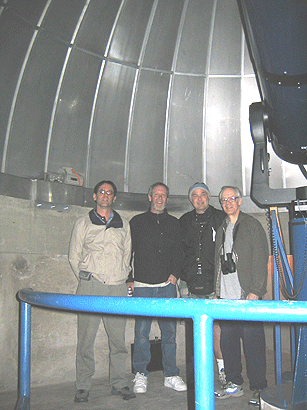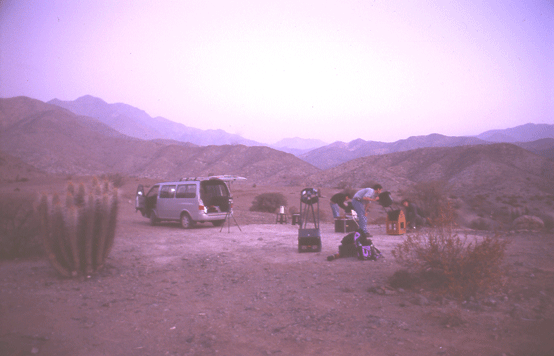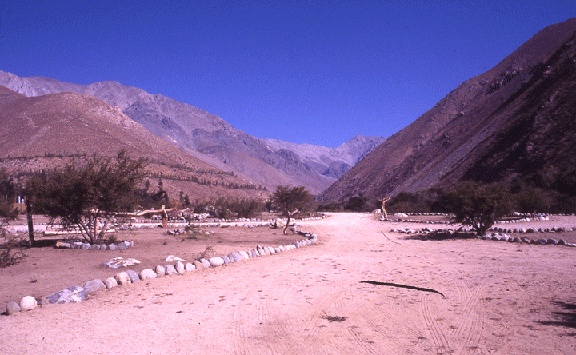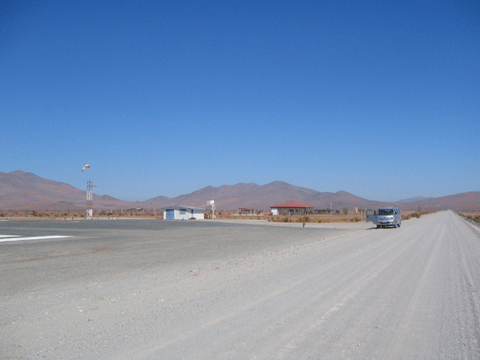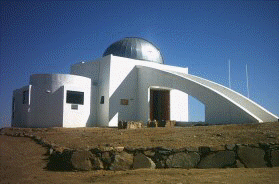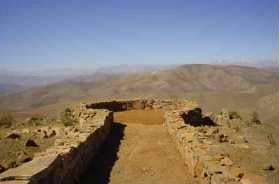|
NGC 4945 Cen. 13 05.4, -49 28 Gal SA: 21 UraSo: 184
VickersSo: 89
A very nice large(ish) elongated galaxy NE/SW. Very even
glow. Tom had this on his list because a supernova was recorded here just a
couple of weeks ago! We tracked the SN down: quite easy in both his 10” and my
13”; stellar point, maybe 13mag. 24mm zoom provided best view.
 |
NGC 2442 Vol 07 36.4, -69 32 SBb Gal SA: 24 UranoSo:
214 VickersSo: 47
Excellent barred spiral! Large “S” shape clearly seen with
direct vision! 11.2 mag.
|
NGC 5286 Cen 13 46.3, -51 22.4 Glob SA:21
UraSo:183 VickersSo: No
Mag11.5. Small, but semi-resolved globular. Next to 6mag
star. 8mm zoom.
NGC 5139 Cen. “Omega Centauri” 13 26.8, -47 29 36.3
Glob SA: UraSo: VickersSo: 92 Mag: 3.7
At 3.7 mag, an easy naked eye object. Truly a glorious
sight in a scope! Stars resolved to the center—an even, gradual concentration
towards the center (unlike 47 Tucanae, see below). The ‘king’ of globs!
NGC 104 Tuc. (47 Tucanae) 00 24.1, -72 05
30.9 Glob SA: UraSo: VickersSo: 3 Mag: 4.0.
Another glorious, naked eye globular! Although about a
quarter of the size of Omega Centauri (therefore comparable to M13), it is no
less magnificent: The intense brightening of the central core adds to the
dynamism and beauty of this glob. One tends to use higher power to resolve the
center, which is easy—even at medium power. The ‘queen’ of globs!
NGC 4755 Cru “The Jewel Box” 12 53.6, -60 20 10 OC
SA: UraSo: VickersSo: 87 Mag: 4.2
The grand-daddy of all open clusters! There is seemingly a
less distant, brighter star cluster super-imposed on this which makes a “V”
pattern, but not so, according to Burnham—these are ‘just’ supergiants; part of
the same cluster. Within this “V” there are also three multi-colored stars
transverse to the main “V.” Truly beautiful!
|
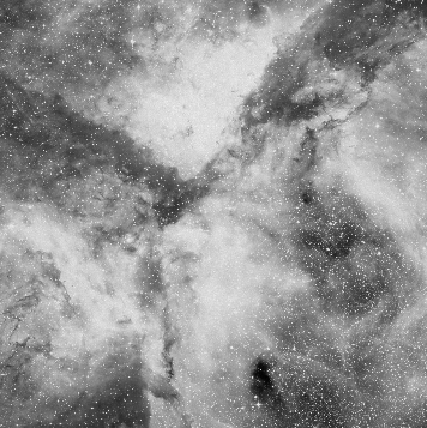
60 arc minute square image from DSS
|
NGC 3372 Car “Eta Carina Nebula”; “Keyhole” 10 43.8,
-59 52 EM SA: UranSo: VickersSo: 72
(Almost) everyones fave! A vast emission nebula, impossible
to get into the entire FOV. Responds well to Ultrablock filter as well as high
power. Billowing three-dimensional clouds viewed doing both of the latter.
Various well defined dark lanes within this nebula make it extremely
fascinating. With M42, high in the northern sky at the same time, it was natural
to compare eyepiece views. M42’s clouds were smaller, tighter and brighter, and
therefore showed color—wisps of dull red and pale green. No color seen in Eta
Carina Nebula; they were much more dispersed, but the patterns were intricate
and well-defined—just not as bright as M42. The Trapezium, with six stars easily
visible, is also an area of interest and beauty in M42 that Eta lacks. However:
Eta Carinae is the boat that drives The Homunculus Nebula, the extremely
energetic star that illuminates much of the Eta Carina Nebula. Unfortunately,
this magnificent item was not on my list! I missed it! Here, however, is Steve
Gottlieb’s notes using my scope a year earlier in Costa Rica:
|
| |
13.1" (2/20/04 - Costa Rica): at 200x, the Homunculus Nebula was
remarkable in excellent seeing on the last evening of observing. Both
Eta and the nebula were a uniquely vivid color - an amazing fluorescent
orange-tangerine. Extending to the SE of Eta is the brighter lobe,
perhaps 6" in diameter with a sharp outline that was flattened along
the southern edge in a mushroom shape. There appeared to be a partial
darker lane in the interior. Extending to the NW was a smaller (4"-5")
and much fainter lobe that faded with increased magnification. A tiny
spike of nebulosity jutted out along to the NE between the two lobes.
This bi-polar reflection nebula resulted from the most recent outburst
of supermassive Eta in 1841. A couple of very close and faint
companions lie just NE of Eta.
The lobes were also clearly visible in Gary Seronik's 8-inch travel
dob, so a large aperture is certainly not necessary – just good seeing.
|
|
NGC 2070 Dor “The Tarantula Nebula”; “#30 Dorado” 05
38.6, -69 05 EM SA: 24 UranSo: 212, a24 VickersSo: 39 Mag: 8.2 Size: 40x25’
A wonderful, enticing nebula! Like M42 or Eta Carina, one
never tires of looking at this over and over again! Responds well to Ultrablock
and OIII filters--the “body” especially becomes more interwoven and three
dimensional.
|
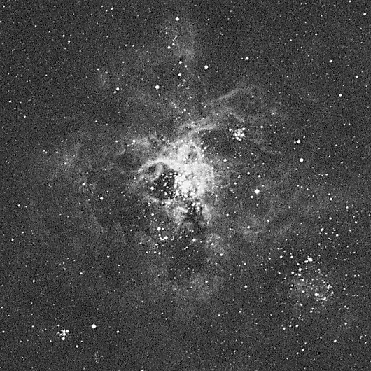 |
NGC 1371 For 03 35.0 -24 56 Gal SA: UranoSo:
VickerSo: 25 Mag 11.5
A rather bright, but non-descript oval galaxy.
Jupiter.
From La Silla airport, where seeing was exquisite, we all
feasted our eyes on ol’ Jove. . . Mark counted 20 cloud bands. The GRS seemed
etched with eye-liner. There was a white oval trailing the GRS, about one-fourth
its size. All four Galilean moons were easily resolved as disks. Ganymede
displayed a ruddy-red appearance. I have witnessed seeing this excellent
maybe once before.
NGC 1385 For 03 37.5, -24 30 Gal SA: UranoSo:
VickersSo: 25 Mag11.0
Looks similar to the non-descript 1371, though I was hoping
to see some irregularity like the Vickers image shows.
NGC 1360=PK 220-53.1 For 03 33.3, -25.51 PN SA:
UranoSo: VickersSo: 24
Nice, large, oval (390”) planetary with 11.4 mag central
star. “Thumb-print-like” appearance. Responds well to Ultrablock, but not
necessary to find.
|
NGC 1365 For 03 33.6, -36 08 SBb Gal SA: 18 UranoSo:
174 VickersSo: 24
Excellent barred spiral gal! Vickers a must here—to get
orientation correct and tease detail out of with higher power. Both arms seen,
but one was brighter. An averted vision delight!
|
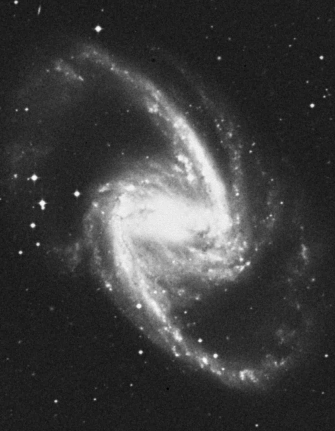
|
Fornax Galaxy Cluster For 03 38, -35 30 Gal Clus SA:
UranoSo:174 VickerSo: No
Sweep around 1365 and you’ll soon find clusters of much
dimmer ellipticals in your view. Five was the most I counted in one
three-quarter degree FOV. NGC 1399 was the brightest.
ESO 356-4 Fornax Dwarf For 02 39.9, -34 32 Gal SA:
18 UranoSo: 175 VickerSo: 16
Had to use 32mm Plossl to sweep around here. Noticed a
brightening as I swept by. Confirmed with other observers (Tom and David).
Confirmed also with the observation of NGC 1049 (a glob) on the northern
(ill-defined) edge. Fornax 5 (another glob) also confirmed, but could not
see any other similarly dim, small globs within this gal. I would like to try
this one again when better placed in the sky.
NGC 1531-2 Eri 04 12.1, -32 52 Gal(s) SA:18 UranoSo:
174 VickerSo:30
Nice, bright (11.1 mag) three-quarter edge-on Sb gal (1532)
with the much smaller 1531 at a right angle to it. 1531 was dim, but there.
NGC 1672 Dor 04 45.7, -59 15 SBb Gal SA: 24 UranoSo:
202 VickerSo: 34
Nice gal with a sprinkling of stars in the same FOV.
Curiously off-balance in regards to the central, bright core. Vickers shows one
“hooked” arm seen from (approx.) face-on.
|
NGC 2207, IC 2163 CMa 06 16.4, -21 22 Sc Gal SA:19
UranoSo:154 VickerSo: 42
Excellent interacting pair of gals: At first, looks like
one gal with dark sideways swath through it—actually the dark swath is the
dimmer of the interacting pair (IC 2163). Also looked at:
NGC 2196 and
NGC 2179--other gals in the hood (a FOV or two
away): Pretty non-descript faint fuzzies.
|
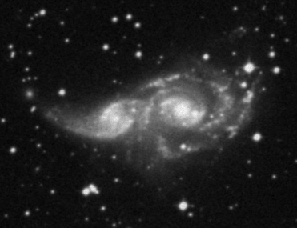
|
Supernova 1987A Dor 05 35, -69 15 SN SA: 24 UranoSo:
A25, A24, 212
On the outskirts of the Tarantula, and discovered by a
tech on a smoke break at Campanias Observatory (which we didn’t visit, but saw
from the ESO at La Silla), I was hoping this was still visible. Uranometria has
a nice finder chart (p.A25). I made sense of the asterisms, but saw nothing in
the finder or main scope at that location. Even “blinked” with an Utrablock to
no avail.
NGC 2217 CMa 06 21.7, -27 14 SBa Gal SA: 19 UranoSo:
154 VickersSo: 43
Takes a nice pic—apparently a face-on with small arms and
distinct halo. Saw (almost) none of that in my 13-incher. Bright core gradually
fading to the two stars in Vickers’ pic.; the halo, I presume—more dramatic in
pic.
NGC 1316-1317 “Fornax A” For 03 22.7, -37 12 S(B)Op,
S(B)a Gals SA: 18 UranoSo: 174-5 VickersSo: 22
Nice, bright ellipticals (mags 9.8 and 11.9). Featureless,
of course.
NGC 1310 (Sb gal) also in the same FOV, but needed
(at first) averted vision to see. Nice overall view of three gals.
NGC 1300 Eri 03 19.7, -19 25 SBb Gal SA: 11 UranoSo:
156-7 VickersSo: 22
11.1 mag barred spiral. Unfortunately, could not tease out
any detail. My notes: bright, diffuse core seemingly a lil off-center. No bars
or arms seen.
NGC 1297 in same field; non-descript oval gal.
NGC 1553, 1549 Dor 04 16.2, -55 47 SO, EO Gals SA:
UranoSo: VickersSo: 31
A bright elliptical pair in the same FOV. Mags 10.5 and
10.9, respectfully.
NGC 1566 Dor 04 20, -54 56 S(b)b+ Gal SA: 24 UranoSo:
202 VickersSo: 31
Excellent face-on gal. Listed as barred spiral, but I don’t
see evidence of this in the eyepiece or Vickers’ image. Two spiraling arms
easily seen. In the same ‘hood as 1553 and 1549 above (NE one degree).
NGC 1536 Ret 04 11, -56 32 Gal SA: 24 UranoSo:202
VickersSo: No
Fairly bright face-on. Some patchiness and irregularity
seen in surface brightness, but no arms, per se. Near 1553, 1549 (SW one
degree).
NGC 1596;1602 Dor 04 27.6, -55 02 SA: 24 UranoSo:
202 VickerSo: 32
Nice pair of gals: One elongated (SB?) mag 11.9, one much
dimmer (13.3), smaller elliptical.
NGC 2397 Vol 07 21.3, -69 00 Gal SA: UranoSo:
VickersSo: 46
Vickers pic not too exciting, but this is a fairly bright (mag
12) SB gal.
NGC 2434 Vol 07 34.9, -69 17 EO Gal SA: 24 UranoSo:
214 VickersSo: 47
Same FOV as 2442; at one mag dimmer (12.3), still direct
vision. Smaller, no detail (EO gal).
NGC 2467 Pup 07 52.6, -26 23 Em SA: 19 UranoSo: 153
VickersSo: 49
Excellent emission nebula in Puppis! Quite bright (7.1),
big (8x7’), and detailed. Beautiful star cluster, too! (Somewhat detached)
nebula trailing to the east.
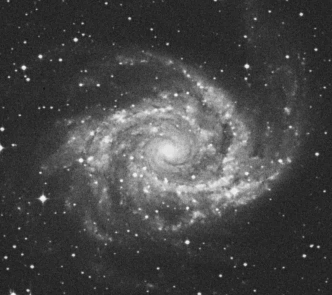 |
NGC 2997 Ant 09 45.6, -31 11 Sc Gal SA: 20 UranoSo:
170 VickersSo: 62
Excellent face-on! Took a long time to star-hop to in the
unfamiliar, star-poor region of Antlia, but well worth it! Showpiece multi-armed
face-on, similar to M51 or M74 in the north. Zoomed in (24 to 8mm) and arms
became much more apparent. Not exactly symmetrical, one arm a lil flattened.
Vickers has an image of this one on the cover to his Southern atlas.
|
NGC 3109 Hya 10 03.1, -26 09 Ir Gal SA: 20 UranoSo:
151, 152 VickerSo: 66
Excellent, large irregular gal! Low surface brightness, but
listed at 10.4! Star superimposed (?) on center, otherwise no central
brightening. Similar, though smaller, to NGC 253.
NGC 3100; NGC 3095 Ant 10 00.1, -31 33 Gals SA: 20
UranoSo: 169, 170 VickersSo: 66
Nice pair of gals separated by about four of their widths.
Look irregular—almost like emission nebula—but are classed S(B). Set in
beautiful star field.
NGC 3115 Sex 10 05.2, -07 43 E6 Gal SA: 13 UranoSo:
133 VickersSo: 67
Very bright (10.1) lenticular gal! Not too often an
elliptical will turn me on, but this one’s a gem!
NGC 3166, 3169, 3165 Sex 10 14.2, +3 28 SA: 13
UranoSo: 112, 113 VickersSo: 68
A trio of gals: One bright pair, separated by only a couple
of their widths, and a faint, small one (3165) on the verge of my averted
vision.
|
NGC 3269 Group (also: 3271, 3267, 3268) Ant 10 30,
-35 13 Gals SA: 20 UranoSo: 169 VickersSo: 70
Excellent galaxy group! The four brightest range from mag
12.6 to 12.9 and are all in the same medium (24mm) field, PLUS at least four
other much dimmer, smaller gals are in this field, too! Sweep around, and more
gals (mostly dim ones) are easily picked up. Fun cluster!
|
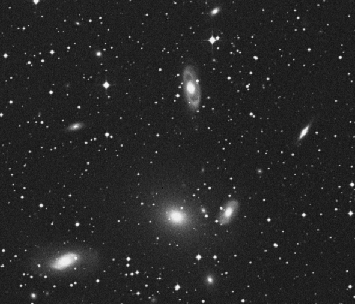 |
NGC 3347, 3358, 3354 Ant 10 42.8, -36 22 SA: 20
UranoSo: 169 VickersSo: 72
Excellent trio of gals! Bright (12.5 and 12.8 for 3347,
3358) Middle fainter one (3354—mag 13.8) is much more dispersed—larger—than
Vickers pic would suggest. No detail seen, except the usual elongations and
ovals... Pic shows 3347 as gorgeous but small, barred spiral.
NGC 5189 Mus 13 33.5, -65 58 PN SA: 25 UranoSo: 208
VickerSo: No
Very nice irregular-looking planetary. Definitely not
round, more rectangular-like, with "mottling." Mag 9.5, 2.3’ in size. Used 9
Nagler with OIII, really no improvement over zoom at 8mm and “blinking”
w/filter.
NGC 2867 Car 9 21.5, -58 18.7 PN SA: 25 UranoSo: 199
VickersSo: No
Smallish planetary (24”)—really looks “planetary-like”;
nice bluish color, too. Mag. 9.7
NGC 2899 Vel 9 27, -56 06.3 PN SA: 25 UranoSo: 199
VickerSo: No
Nice lil puff of a planetary. Ultrablock brings out some--a
crisper western edge. 117”x75”. Mag. 12.2
NGC 3195 Cha 10 09.3, -80 51.5 PN SA: 25 UranoSo:
218 VickersSo: No
Smaller than 2899 (42”), and dimmer—though at (p)
magnitudes, 2899 is listed as dimmer: 12.2 v.11.5.
NGC 3211 Car 10 17.8, -62 40.3 PN SA: 25 UranoSo:210
VickersSo: No
Small (16”) bright (10.7) planetary. Good with or without
filter (Ultrablock).
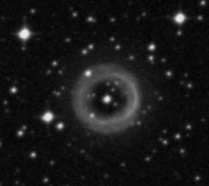 |
Shapley 1 Nor 15 51.7, -51 31.3 PN SA: 25
UranoSo:196 VickersSo: 102
This one skunked me in Hawaii a few years back, and I had
trouble finding it in Chile, too—but finally did! Could not make sense of the
star fields, but did pick it up sweeping the field. Tough object (mag 13.6),
barely seen at moderate power w/out Ultrablock. With filter and higher mag,
becomes a circular, faint glow. Averted vision brings out annularity as well as
central star, and—surprisingly—a couple of other stars (intermittently) within
the ring! Very satisfying object.
|
NGC 3132 Vel 10 07, -40 26.1 “Eightburst Nebula”;
“Southern Ring” PN SA: 20 UranoSo:169 VickersSo: No
Nice, annular planetary, with central star (mag 10) easily
seen. The planetary itself is not near as bright as the northern “ring,” or as
beautiful, IMO; but I can see the resemblance.
NGC 4945 Cen 13 05.4, -49 28 Gal SA: 21 UranoSo: 184
VickersSo: 89
Excellent, showpiece galaxy! Long, thick, fairly even
illumination—some mottling, to keep your eye interested. Similar to 253 and NGC
3109 (see above for notes on latter). Mag 9.5. Size: 4.4x20’
NGC 2736 Vel 09 00.4, -45 54 SNR SA: 20 UranoSo: 186
VickersSo: 55
A supernova remnant. With OIII, just a wisp filling the
eyepiece view (24mm zoom), but nothing more, really—no filamentary structure.
NGC 2613 Pyx 08 33.4, -22 58 Gal SA: 20 UranoSo: 153
VickersSo: 52
Nice, bright, three-quarter tilted gal, but badly
positioned (low) in sky.
In and around the SMC:
- 47 Tucanae, of course (see description above).
- NGC 362 Tuc 01 03.2, -70 50.8 Glob SA 24 UranoSo:
A26 VickersSo: 9
Quite nice glob about one-fourth the size (14’ v. 50’) of
47 Tucanae, but with the same morphology—an intense core! Mag 6.8 Size: 14’ Nice
Glob—not to be overlooked!
- NGC 346 Tuc 00 59.1, -72 11 OC/Nb SA: 24 UranoSo:
A26 VickersSo: 8
Nice emission neb and star cluster just three-quarters of a
degree SSW of 362 w/NGC 371, an OC, in same FOV.
- NGC 406 Tuc 01 07.4, -69 52.7 Gal SA: 24 UranoSo:
A26 VickersSo: 9
Tough lil gal (13.1) a degree North of 362.
- NGC’s 456, 460, 465 Tuc 01 15.7, -73 20.2 SA: 24
UranoSo: A26 VickersSo: 10
Very nice clumps of emission nebulae and small star
clusters set within two parallel lines of stars.
Around the LMC and The Tarantula:
- Lots of small (distant) open clusters w/ associated
nebulae—quite overwhelming! (Could spend a lot of time here!) However: very
fun—and economical—to just sweep around!
- NGC 2029 Dor 05 35.5, -67 34 SA: 24 UranoSo: A25
VickersSo: No
Quite impressive emission nebula a degree and a quarter
north of The Tarantula. Bisected by dark lane. Several other nebs in same field:
NGC’s 2014, 2032, 2040, 2035.
- NGC 2018 Men 05 31.2, -71 04 SA 24 UranoSo: A25
VickersSo: No
SSW of The Tarantula about a degree and a half. Impressive
glow with at least two embedded stars.
|
NGC 3576 Car 11 12.2, -61 12 EM SA: 25 UranoSo: 198
VickersSo: No
Excellent emission nebula with several darklanes, detached
pieces (with their own NGC #’s). Viewed in Mark’s 10” and my 13”—significantly
more detailed in my 13. Did not respond well to Ultrablock.
|
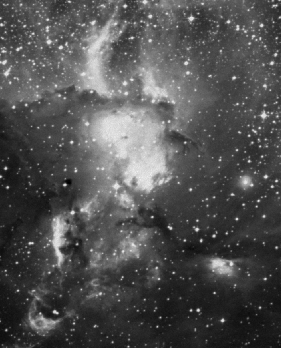
|
|
NGC 3199. Car 10 16 37, -57 55 13 EM SA: 25 UranoSo:
199 VickersSo: No
Steve Gottlieb’s “Southern Crescent.” Very beautiful,
“medium-sized” (11’x7’) nebula in the form of a crescent arc. Well defined
western (outer) edge. Higher power reveals more structure/nebulosity/contrast.
Visually, reminds a northerner of NGC 6888, “The Crescent,” hence Steve’s
nickname. Curiously, both 6888 and 3199 are illuminated by a Wolf-Rayet star, a
rare sight through any telescope. Loke Tan (an imager that was visiting us
visual astronomers at the time of our observation), thought this might be the
“Gabriela Mistral Nebula.” Though close by, and similar in appearance, it is
not. The aforementioned is NGC 3324 (see below).
|
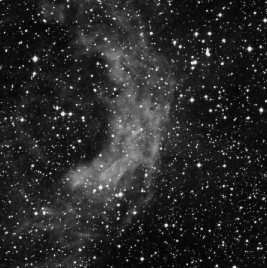
|
|
NGC 3324 Car 10 37 19, -58 39 36 EM, OC SA: 25
UranoSo: 199 VickersSo: No
6.7 mag. A bright, detached HII ‘knot’ near the NW
outskirts of the Eta Carina nebula (just follow the largest dark lane to its
widest portion, and you can’t miss it). Illuminated by an associated star
cluster (CR 225), this nebula forms an arc quite a bit brighter and a little
larger than the rather dim 3199 (both images from the DSS site, and both are 15
arc minutes square). This is the locally named Grabriela Mistral
Nebula. In detailed photos, there is an absolutely uncanny resemblance to a
famous profile photograph of the poet Gabriela Mistral, the 1945 recipient of
the Nobel Prize for literature—the first South American to receive this
accolade. She was native to this region of Chile, namely the town of Vicuna,
just an hour away from where we were observing. See Daniel Verschatse’s image:
http://www.astrosurf.com/antilhue/NGC%203324.htm
|
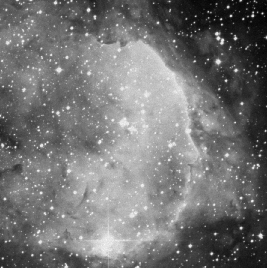 |
M83 Hya 13 37, -29 52 Gal SA: 21 UranoSo:167
VickersSo: 93
Hands down the best galaxy—and a barred spiral to boot—the
southern skies have to offer—at this time of year. At zenith (3:30am local) one
night, Mark and I feasted on this for quite a while… Truly photographic-looking!
Bar and spirals clearly seen. And BRIGHT! Mag 7.6 Bright, smallish central core.
Lots of dark space between arms—two most outward arms drift—and fade
off—beautifully!
|
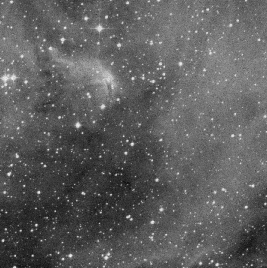 |
IC 2948 Cen 11 38 19, -63 18 00 EM SA: 25 UranoSo:
209 VickersSo: No
"Running Chicken Nebula." Excellent large emission nebula.
Responds well to Ultrablock; dark lanes, various intensities of "fog." Sweeping
around a must!
|
Gum 39 Cen 11 28 54, -62 36 00 EM SA: 25 UranoSo:
209 VickersSo: No
Nice circular even glow EM nebula. Fills about one-quarter
of the FOV at low power. No defined edges or lanes seen.
NGC 3918 Cen 11 50 18, -57 10 58 PN SA: 25 UranoSo:
198 VickersSo: No
The "Blue Planetary." Indeed! Small (19"), bright (mag 8.4)
and definitely blue. Stands out as bluish planetary even at low power.
Gum 12, Supernova Remnant, Vela 08 31, -44 00 SA:
20 UranoSo: 187 VickersSo: No
How this did not make any of my lists, I don’t know!
“Found” it by seeing its unbelievable plot on Uranometria—it covers about 3x4
degrees! An easy star hop to several of its fields, Mark and I were on it in a
flash. Responds well to OIII and the widest field eyepiece you have. Not nearly
as bright or “filament-like” as The Veil, but just HUGE. One can easily follow
threads for many minutes and still not wind up where you started! At one time I
had two threads going across the whole FOV. This was the last telescopic object
we looked at—a nice surprise to end with!
HOME |
|
